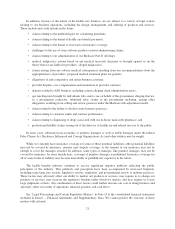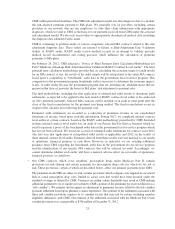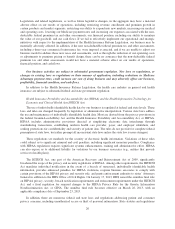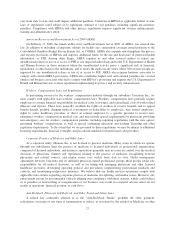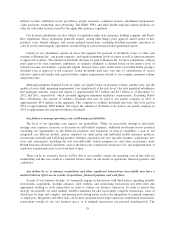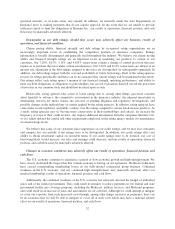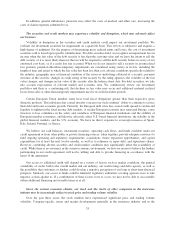Humana 2012 Annual Report Download - page 40
Download and view the complete annual report
Please find page 40 of the 2012 Humana annual report below. You can navigate through the pages in the report by either clicking on the pages listed below, or by using the keyword search tool below to find specific information within the annual report.failure to successfully integrate acquired entities and businesses or failure to produce results consistent with the
financial model used in the analysis of our acquisitions may have a material adverse effect on our results of
operations, financial position, and cash flows. If we fail to identify and complete successfully transactions that
further our strategic objectives, we may be required to expend resources to develop products and technology
internally. We may also be at a competitive disadvantage or we may be adversely affected by negative market
perceptions, any of which may have a material adverse effect on our results of operations, financial position, and
cash flows.
If we fail to develop and maintain satisfactory relationships with the providers of care to our members,
our business may be adversely affected.
We own or contract with physicians, hospitals and other providers to deliver health care to our members.
Our products encourage or require our customers to use these contracted providers. These providers may share
medical cost risk with us or have financial incentives to deliver quality medical services in a cost-effective
manner.
In any particular market, providers could refuse to contract with us, demand higher payments, or take other
actions that could result in higher health care costs for us, less desirable products for customers and members or
difficulty meeting regulatory or accreditation requirements. In some markets, some providers, particularly
hospitals, physician specialty groups, physician/hospital organizations, or multi-specialty physician groups, may
have significant market positions and negotiating power. In addition, physician or practice management
companies, which aggregate physician practices for administrative efficiency and marketing leverage, may
compete directly with us. If these providers refuse to contract with us, use their market position to negotiate
favorable contracts or place us at a competitive disadvantage, our ability to market products or to be profitable in
those areas may be adversely affected.
In some situations, we have contracts with individual or groups of primary care providers for an actuarially
determined, fixed, per-member-per-month fee under which physicians are paid an amount to provide all required
medical services to our members. This type of contract is referred to as a “capitation” contract. The inability of
providers to properly manage costs under these capitation arrangements can result in the financial instability of
these providers and the termination of their relationship with us. In addition, payment or other disputes between a
primary care provider and specialists with whom the primary care provider contracts can result in a disruption in
the provision of services to our members or a reduction in the services available to our members. The financial
instability or failure of a primary care provider to pay other providers for services rendered could lead those other
providers to demand payment from us even though we have made our regular fixed payments to the primary
provider. There can be no assurance that providers with whom we contract will properly manage the costs of
services, maintain financial solvency or avoid disputes with other providers. Any of these events may have a
material adverse effect on the provision of services to our members and our results of operations, financial
position, and cash flows.
Our pharmacy business is highly competitive and subjects us to regulations in addition to those we face
with our core health benefits businesses.
Our pharmacy business competes with locally owned drugstores, retail drugstore chains, supermarkets,
discount retailers, membership clubs, and Internet companies as well as other mail-order and long-term care
pharmacies. Our pharmacy business also subjects us to extensive federal, state, and local regulation. The practice
of pharmacy is generally regulated at the state level by state boards of pharmacy. Many of the states where we
deliver pharmaceuticals, including controlled substances, have laws and regulations that require out-of-state
mail-order pharmacies to register with that state’s board of pharmacy. In addition, some states have proposed
laws to regulate online pharmacies, and we may be subject to this legislation if it is passed. Federal agencies
further regulate our pharmacy operations. Pharmacies must register with the U.S. Drug Enforcement
Administration and individual state controlled substance authorities in order to dispense controlled substances. In
30



